How to Practice Violin with a Metronome + FREE online metronome | Violin Lounge TV #548
Complete guide to practicing with a metronome
Improve your rhythm and learn all about note values, tempo markings
Check out my FREE online metronome right here, so you have a metronome at hand when watching this tutorial.
Why practice with a metronome?
If you are a violinist at ANY stage of learning, I can almost guarantee this is something that you’ve heard many times before. Using a metronome is a great practice technique if used in the correct way. If used improperly, it’s just a frustrating clicky sound that will haunt your dreams. Kidding! Kind of.
In this blog I will help you practice effectively with your metronome
You’ll learn all about
- the best type of metronome for you
- how to start practicing with a metronome
- how to play faster with the help of a metronome
- how to practice difficult rhythms with a metronome
After that you’ll read all about rhythm in general
You’ll learn all about
- reading rhythm in sheet music
- time signatures
- note values
- common tempo markings in music and their BPMs (handy table)
Let’s start with the basics…
What is a metronome?
A metronome is a device (either mechanical, electronic, or online) that produces a steady pulse, using both aural and visual cues. The pulse is measured in BPM (Beats per Minute). For example, 60 BPM is essentially one beat per second, while 120 BPM is two beats per second.
Mechanical vs Electronic vs Online Metronome
What’s the best type of metronome?
There are three basic types of metronomes: mechanical, electronic, and online. Here’s how they work and what the pros and cons are:
Mechanical Metronome
Mechanical metronomes have a pyramid-like shape with a swinging pendulum down the middle. The pendulum swings left to right, and the metronome emits a clicking sound each time the pendulum reaches each side. These metronomes are more old-school and sometimes require the user to wind them up before use.
Pros
- Clear pendulum
- Nice click
- Decorative (come in cute designs, colors or even piano gloss)
Cons
- Winding
- Expensive
- Limitied functionality
Digital metronome
Electronic metronomes are hand-held digital devices. You can set the BPM with a wheel or with buttons. Most of them have lights that light up with the corresponding click. Some of them even have a display with a pendulum. They are more compact than mechanical metronomes.
Pros
- Compact compared to mechanical
- No winding
Cons
- Batteries
- Expensive
- Often no visible pendulum
- Limitied functionality
Online Metronome or Metronome App
Online metronomes come in a wide variety. They can look a bit like an electronic metronome or more like a traditional, mechanical metronome.
Pros
- You always have it with you on your smartphone, tablet or laptop
- More functionalities like subdivisions for different rhythms
- FREE (like my online metronome) or low cost
Cons
- Not so decorative in your practice room
- You can get distracted on your phone and start scrolling instead of practicing
What are the benefits of practicing with a metronome?
There are several things that practicing with a metronome can help with. They include but are not limited to:
- Keeping a steady pulse. When I first started to practice with a metronome, I swore to my teacher that it was the one changing speeds, not me! It’s only natural to speed up when things are easy and to slow down when things are hard. The metronome helps you identify this and work to correct it.
- Understanding complex rhythms. Not all music is made up of quarters and half notes (if only it were that easy!). The best way for practicing and understanding complex rhythms is subdividing, which we will cover later in this article.
- Improving difficult runs. There are some runs (which are simply a long string of fast notes) that just seem impossible! Practicing with a metronome will greatly improve your chances for success (covered more in detail below).
- Getting a piece up to performance tempo. Say you can comfortably play a piece at 60 BPM, but it’s marked at 100 BPM. How are you going to make up that difference? Well, by using the metronome, of course!
When to practice with a metronome?
When practicing, it is important to use the right practice techniques for the problem you’re looking to solve. Practicing with a metronome is not going to help you with intonation, but it can help if you’re having the following issues:
- Maintaining an even tempo throughout the piece.
- Struggling with accurate rhythm.
- Having issues getting the piece to “flow”.
- Not able to play certain passages up to speed.
- Wanting to generally increase the speed at which you can play.
Metronome practice tips
How to practice music with a metronome
How you use the metronome in practice will depend on your skill level
Beginning players need to first get comfortable playing simple rhythms with the metronome. If you’ve never used the metronome before (or are struggling to get started) here are some steps to follow.
- Place your metronome on at 60 BPM.
- Practice clapping with the metronome on various simple rhythms. Start with quarter notes (one clap per click), then half notes (one clap per two clicks), and then eighth notes (two claps per click).
- Practice playing these simple rhythms on open strings.
- Practice scales in these simple rhythms.
Playing with the metronome is going to take a lot of brainpower at first, and that’s okay!
I always recommend for beginners only focus on staying with the metronome when learning how to use it. If you’re trying to stay with the metronome, plus working on your intonation, trying to make sure your bow is straight, and trying to keep your fingers close to the string, there are way too many things to think about and something is bound to fall by the wayside! These things are obviously important but should be addressed away from the metronome.
If you’re faced with challenging rhythms that you can’t quite decipher, the best practice technique is going to be subdividing.
Subdividing is essentially dividing up each note into the smallest common denominator, thus making it easier to keep track of and count. Follow these steps to practice subdividing.
- Identify the smallest common denominator of the passage (ie the smallest note value).
- Change the setting on your metronome to correspond with that note value.
- Determine how many of each of those note values go into larger note values. For example, if you determine that your smallest common denominator is 16th notes, figure out how many 16th notes go into each of the larger note values (this also includes ties).
- Play the written rhythm while the metronome is clicking the subdivisions. It should be much easier to count.
If you’re looking to increase your general speed of a piece, here are the steps you need to follow to gradually work it up with the metronome.
- Pick a section of the piece (not the whole thing!)
- Identify a tempo where you can play it comfortably, no matter how slow. All notes, rhythms, and dynamics should be accurate.
- Play that section at least 3 times with the metronome with no mistakes.
- Move the metronome up slightly, by no more than 5 clicks, and repeat.
- Aim to increase the speed by 5-15 clicks per day.
But I just can’t play any faster! What do I do?
First, recognize that gradually increasing your speed takes time. Depending on the difficulty of the piece, give it at least a few months before declaring that you’ve reached a plateau.
If you really can’t go any faster, increase the speed by 10-20 BPM. I know it sounds crazy, but stay with me for a second. Play the section a few times at this new faster speed. It doesn’t have to be perfect but aim to get through it. Then increase the speed again and repeat the process. Now, go back to the original, desired speed. It should seem much slower and more manageable.
Rhythmical Variations
The best way to increase your speed in runs is to practice rhythmical variations. The aim of this practice technique is to practice just a few notes at a time, but at a very quick speed, which will increase the overall speed at which you’re able to play the run. Here are the steps to follow to practice in rhythmical variations:
- Play two notes as fast as possible. Take out all bowings and play each note separately.
- Stop for as long as necessary to mentally prepare for the next two notes.
- Repeat for the remaining length of the run.
- Now, practice in opposite pairs. To do this, start out with a single note, and then resume playing in pairs. You should be playing different pairs than before.
- Repeat the process with groups of three, four, six, and eight.
Using a metronome to practice violin vibrato
Did you know that you can use a metronome to practice vibrato!? Yes, it’s possible and extremely effective! Practicing vibrato with the metronome is a great way to practice the vibrato motion and make sure your vibrato is even. Follow these steps to practice vibrato with the metronome.
- Place your metronome on 60 BPM.
- Practice your vibrato in quarter notes (one movement per click. I also call this “pizza”).
- Practice your vibrato in eighth notes (two movements per click. I call this “pepperoni”).
- Practice your vibrato in sixteenth notes (four movements per click. I call this “I would like a slice of pizza.”
- Gradually increase the speed of the metronome as you feel comfortable.
Difficult rhythms to practice with a metronome
Dotted rhythms (dotted quarters, dotted eighths followed by sixteenths, etc)
These rhythms are challenging because you have to play off of the beat (meaning that you are not going to be playing right with the click of the metronome.) However, when practicing along with this online metronome, you can simply choose these rhythms in the bottom right-hand corner and play exactly with the beats.
Triplets (especially when in combinations of eighths and quarters)
The most common tendency when practicing triplets is to rush. I like to call triplets “the lazy rhythm” to help remind students to evenly spread the three notes out over the beat. When faced with triplets in combinations of eighths and quarters, I recommend subdividing the triplet in your head.
Syncopated rhythms
Syncopations are difficult because you have to play off of the beat of the metronome (similar to dotted rhythms). Along with subdividing and using the built-in syncopation rhythms in this online metronome, I recommend listening to the piece as much as possible to internalize the rhythm.
Why is practicing with a metronome so difficult?!
In short, it is one more thing to add to the long list of things to worry about during practice. A metronome shows no mercy, which can make it an incredibly difficult practice partner. Overall, the metronome is a practice tool that should enhance your practice, not leave you miserable. If you can get through the initial challenges of learning how to most effectively use it, then the metronome truly can become a great tool to add to your practice toolkit.
Learn all about rhythm
What are time signatures?
In order to effectively use the metronome for practice, you must first understand time signatures. Time signatures are made up of two numbers. The top number indicates how many beats are in each measure and the bottom number indicates which note is equivalent to a beat. For example, in the time signature ¾, the top number 3 tells us there are 3 beats in the measure, and the bottom number 4 tells us the quarter note gets the beat. If you were to see a 2 on the bottom, that indicates the half note gets the beat, an 8 indicates that the eighth note gets the beat, and a 16 indicates that the sixteenth note gets the beat. You can think of the beat as one metronome click.
The standard rhythm is 4/4. If you see a big e in front of the music where the measure usually is, the measure is 4/4. A waltz is usually a 3/4 measure. A tango is often a 2/4 measure.
How does the time signature relate to the metronome?
Metronomes emit a higher-pitched click on the first beat of each measure, which is why it is important to set them to the time signature of the piece you’re practicing. Accenting the first beat of each measure is helpful because it makes it very easy to tell if you are with the metronome or not. Say you were in the middle of a measure and hear the higher-pitched click indicating beat one; you will immediately know that your tempo is off. It is up to you to determine if you were playing too fast or too slow, and adjust your tempo accordingly.
Note Values
Rhythms let us know when a note should be played and how long a note should be held for. Here are some of the most common rhythms and how many beats they get in a 4/4 measure.
A whole note gets four beats.
A half note gets two beats.
A quarter note gets one beat.
An eighth note gets half a beat. (Two eighth notes equal one beat).
A sixteenth note gets one-quarter of a beat. (Four sixteenth notes equal one beat).
Dotted Rhythms
Whenever you see a dot next to a note (directly next to it, not under or over it as that means something else entirely), it tells us to add half of that note’s value to that note. Let’s use a dotted half note as an example. A half note gets two beats- half of two is one, so I add one beat to the note getting a total duration of three beats.
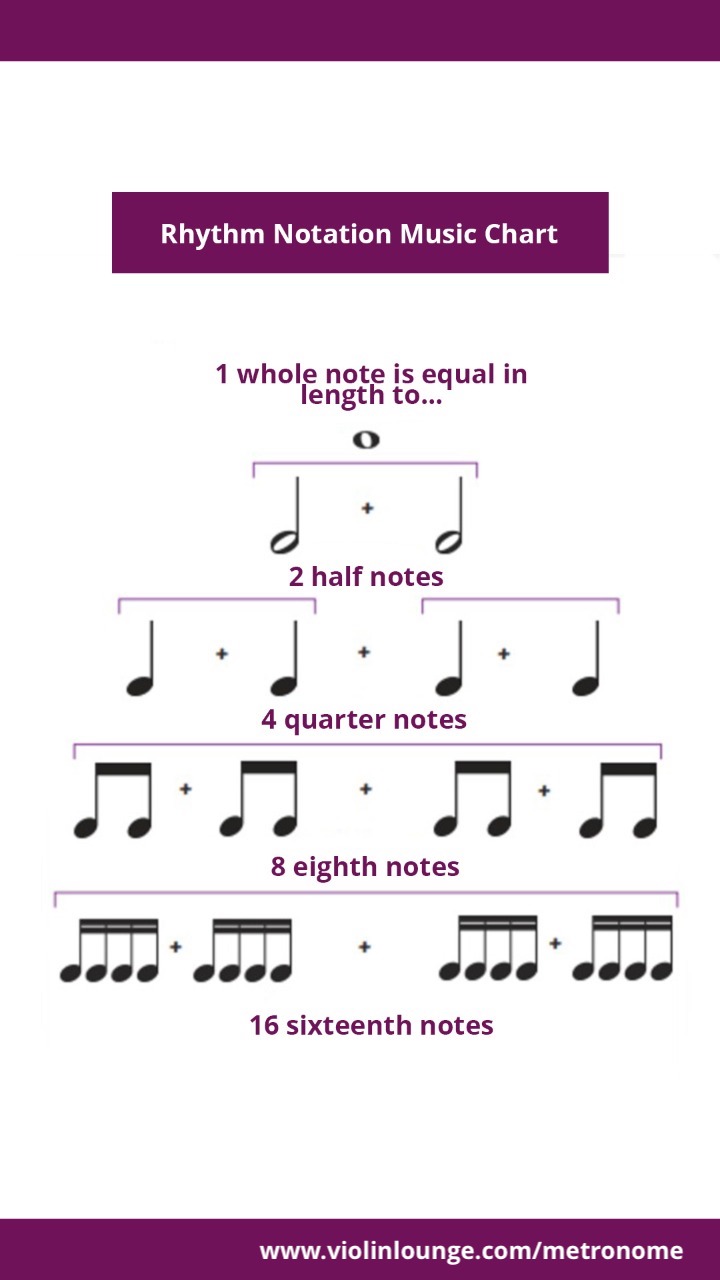
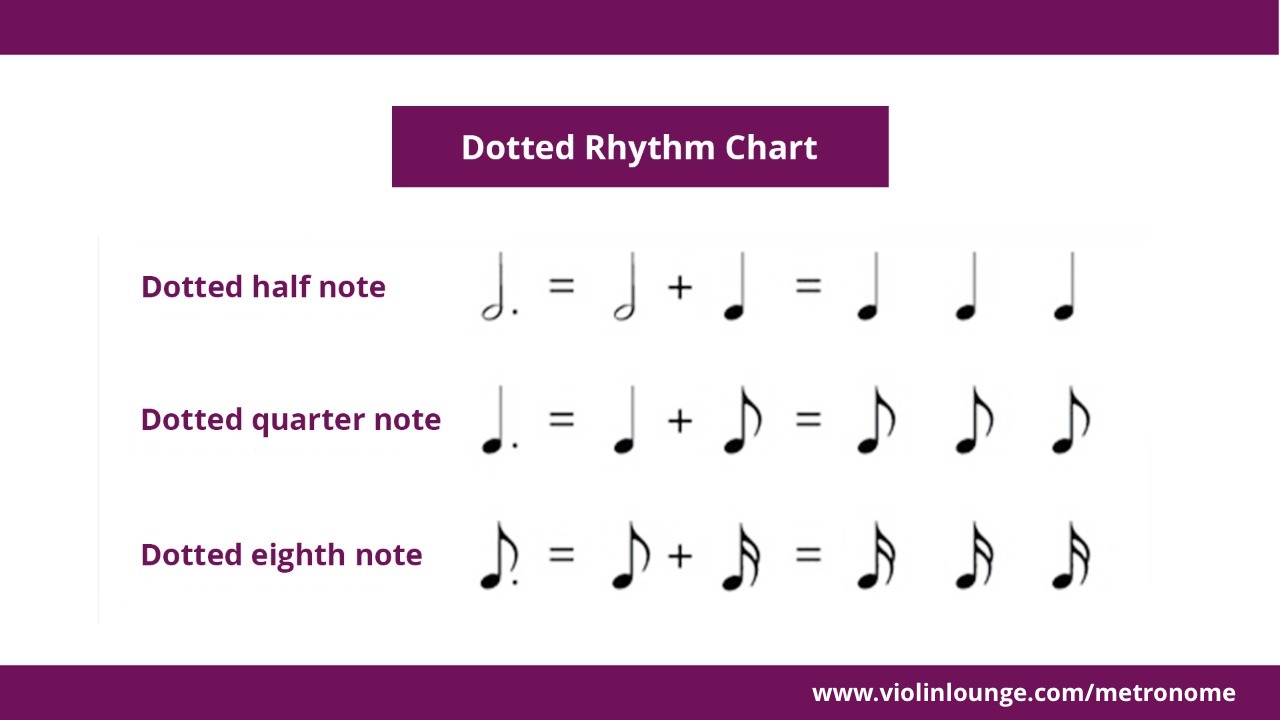
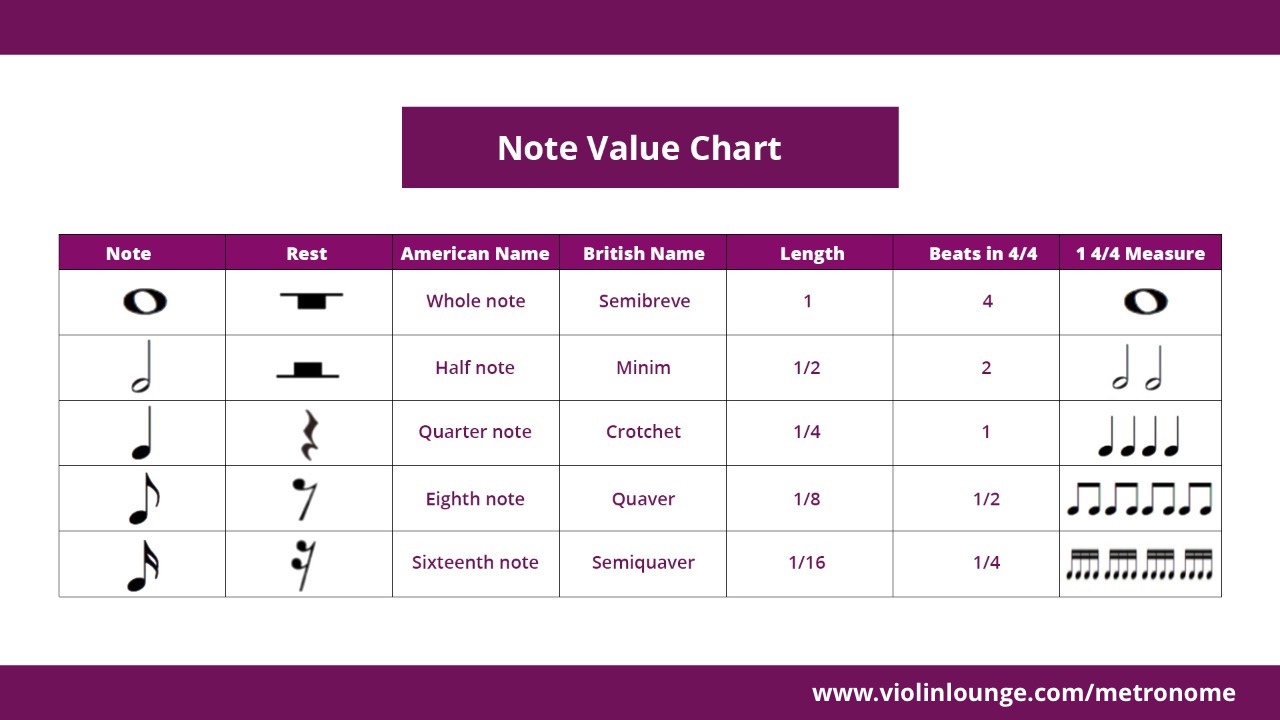
What BPM should I use?
This totally depends on the piece! The BPM is not defined by the time signature, but instead by the tempo marking. The tempo marking is most often an Italian term notated at the beginning of the piece. In longer pieces, you may also find that the tempo changes and new tempo markings are given at the beginning of certain sections. Additionally, some pieces may indicate the BPM at the beginning of the piece in which case, you can easily see exactly what speed to use!
If there is no speed or tempo marking indicated, listen to recordings to get a general feel for the tempo. You can use your metronome to click along to the recording and adjust until you find a BPM that is relatively close to what you hear.
Below we’ll go a bit deeper into common tempo markings you find in violin sheet music.
Common Tempo Markings in Music
When you embarked on your violin journey, did you know you’d have to learn a bit of Italian too?! Tempo markings are generally (but not always) in Italian, simply because the majority of the 17th-century composers were Italian, which was the time when tempo markings were first extensively used and codified.
Here is a comprehensive list of Italian tempo markings and their corresponding BPMs:
Slow Tempo Markings
Tempo Marking
Translation
Beats per Minute (BPM)
Moderate Tempo Markings
Tempo Marking
Translation
Beats per Minute (BPM)
Fast Tempo Markings
Tempo Marking
Translation
Beats per Minute (BPM)

Hi! I'm Zlata
Classical violinist helping you overcome technical struggles and play with feeling by improving your bow technique.
What if the metronome only seems to distract you?
Learning to practice effectively with a metronome takes some time, but will save you time and get you better results in the future.
I know the metronome might feel like an enemy in the beginning and only seems to slow you down or distract you from your music. However, just continue and it will be your best friend as a musician.
Make sure not to practice with a metronome all the time. You might get frustrated and your playing might become mechanical. The end goal is to be able to play rhythmically and at the right tempo without the metronome, as you won’t take it with you on stage.
How do you practice with the metronome?
Share it in the comments below!

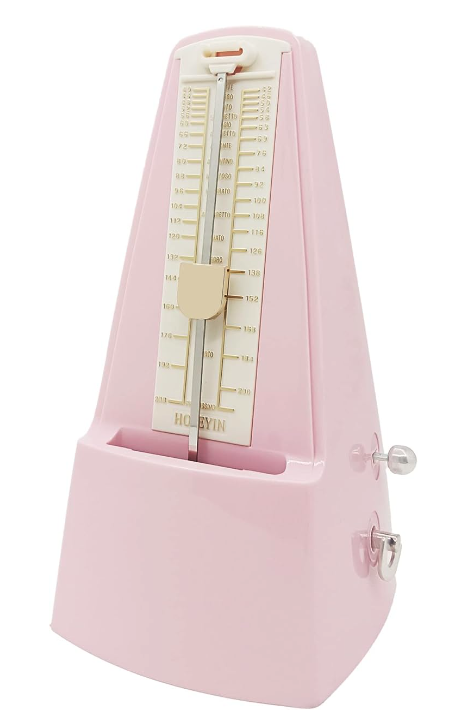
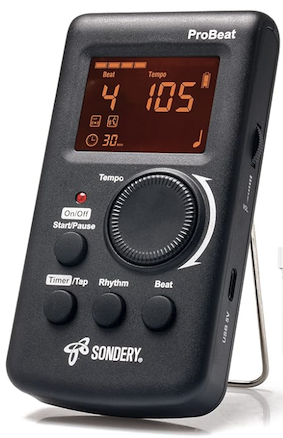
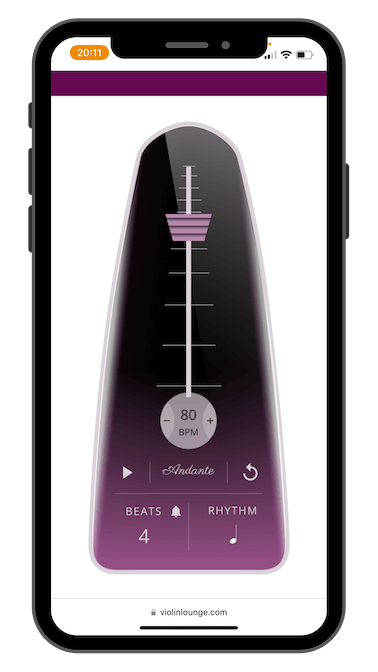
0 Comments